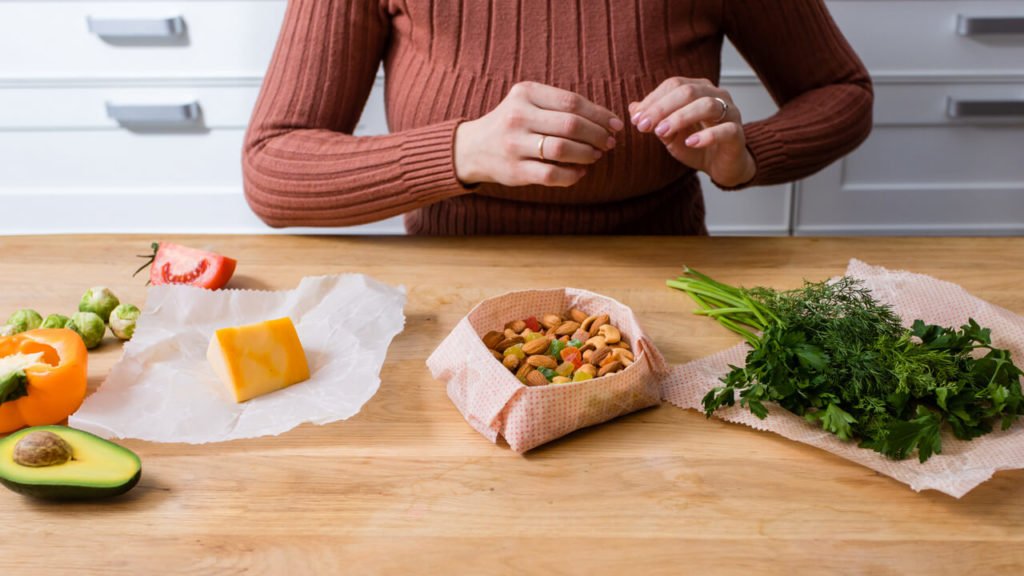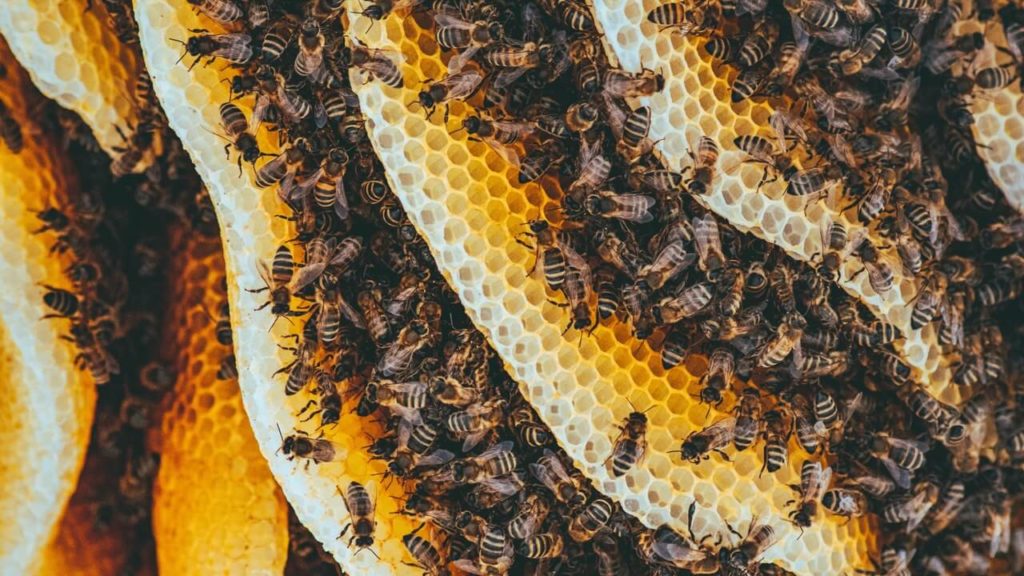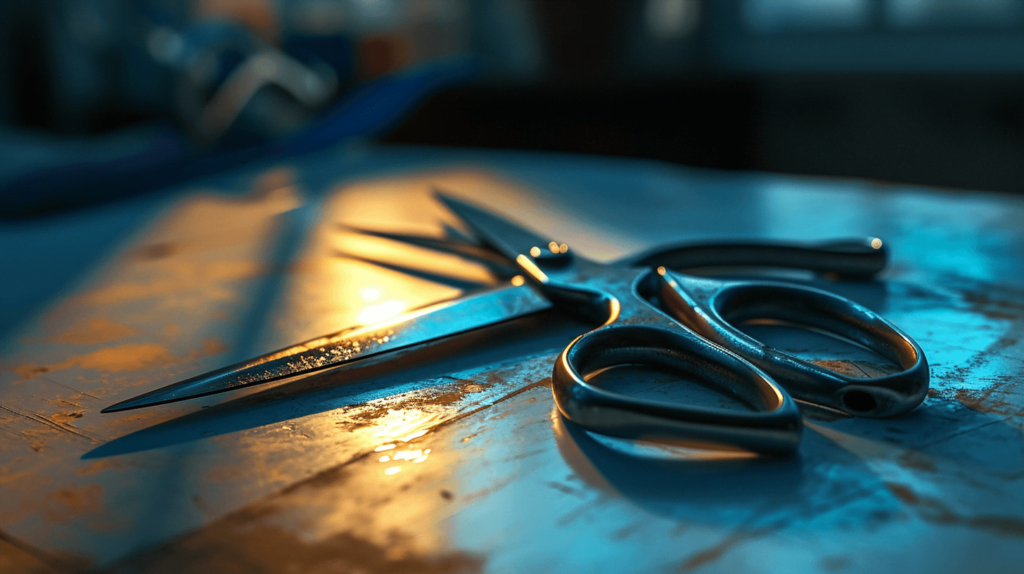If you’re reading this, you’re surely already convinced of how awesome they are as alternatives to plastic food wraps. First of all, congratulations! By using beeswax wrap, even occasionally, you’ve already reduced the environmental harm caused by plastics clogging up landfills, oceans or the landscape.
The great thing about beeswax wrap is that they are not single-use. You can refresh them when they lose their natural ability to seal, something I’ll show you how to do in this article.
I’ve already talked about the best beeswax wraps online, but if you’re looking for a DIY project why not just make them yourself?
I’ll show you how to do exactly that. You can skip ahead if you like, because first I’m going to share why I think beeswax food wraps are a must for every kitchen.
Beeswax wraps are cloth alternatives to cling wrap. They’re made from fabric that is coated in a layer of beeswax and other ingredients, like rosin and jojoba oil.
Beeswax wraps seal jars or food containers in your fridge or freezer. Using the heat of your hands, the beeswax layer melts and molds around the shape of the container you want to seal.
As it cools, it creates a breathable, antibacterial seal that keeps food fresh. It’s a non-toxic, sustainable and eco-friendly alternative to plastic wrap. It can be reused, refreshed, and (depending on the fabric that you’ve chosen), is compostable at the end of its long life.

In a pinch, you can also use beeswax wrap to open tough jars. The natural grip of the treated material really adds torque and grip when there’s a lid that just refuses to budge.
If you take care of them correctly, beeswax wraps can last for over a year before you need to refresh them.
For making beeswax wraps you will need:
This is available at home stores or available online at many outlets. It’s ideal to use cosmetic-grade beeswax pellets. If you’re using packed beeswax (a bar), you’ll need a cheese grater to shave thin strips of beeswax.

Besides having antimicrobial properties, Jojoba oil makes the beeswax wrap soft and malleable when it’s cool. Check your local health stores, co-ops, or online.
This is the ingredient that gives the beeswax wraps their stickiness to surfaces.
I prefer to use organic cotton because the manufacturing process is more earth-friendly than its chemically prepared counterpart. You can cut up any unwanted cotton material to be the base of your homemade beeswax wrap.
The advantage that pinking shears have over regular scissors is that the edge of the fabric won’t fray and create loose threads at the edges of the cloth. In my experience, the wax coating will do enough to prevent the threads from fraying.

Any fine paintbrush will do to evenly spread the sticky beeswax mixture to your cloth. Pick this up from any hardware store or art supplier.
This is the surface you’ll be working on to coat the material with the wax and oil. It absorbs any excess beeswax mixture that you apply to the fabric.
You’ll be placing the prepared material into the oven on a baking sheet of your choice.
After you’ve taken the homemade beeswax wraps out of the oven you’ll be needing these to air dry, set and cure the beeswax wraps.
This depends on how big a beeswax wrap you’re making.
These are approximate measurements based on my own experience. Of course, the more practised you become, the better you’ll get at gauging how much of each ingredient you’ll need to refresh or create.
The beeswax wraps will be really tacky when new. This is natural and will wear off in time. If you find that it is excessively tacky, all you need to do is pop it in the oven once more until the liquid melts, pop it on a fresh sheet of parchment paper, and lightly brush off any excess melted wax from the fabric before hanging it to air cool.
With proper care, your homemade beeswax wraps can last for up to a year. Close to the end of their life, they will lose their stickiness, or they will not hold their shape as well as when they were brand new. This means that they are due to be refreshed.
To refresh your beeswax wrap, whether it’s homemade or store-bought, all you have to do is place it in the oven at 225 degrees fahrenheit to reactivate any remaining beeswax, oil and rosin mixture from the deeper fibres of the material. You can also use your clothes iron to apply a quick hit of heat onto the surface to reactivate any deep-set beeswax.
Note: the same applies to store-bought beeswax wraps.
After using your food wrap it will be due for a clean. Luckily, this is a very easy process.
Your homemade or store-bought beeswax wrap is less likely to stain if it’s new, or recently refreshed with a new coating of beeswax. But when it comes into contact with deeply pigmented foods, like berries or beets, it could leave a stain. There are things you can do to prevent deeper stains.
Remember, stains are not dirt. They’re a sign of natural, well-used beeswax wrap. Stains on beeswax wraps are natural and nothing to be afraid of.
Yes, it’s possible to make beeswax wraps with just beeswax and no resin. However, the effect of adding resin makes the beeswax wrap tackier, and be able to cling a lot more effectively to itself and the container that you’re looking to seal. If you’re not using pine resin, or rosin, you’ll probably have to use an elastic band to seal the beeswax wrap around the jar to reinforce the grip.
Cracking means that the beeswax has become displaced, or worn down in the fabric. This is a normal result of regular use. You can solve this by applying heat to the surface either in the oven or with a clothes iron to evenly redistribute the beeswax throughout the fabric.
If your beeswax wrap is not sticking, it’s because over time there the wax has worn down. Or if your homemade wraps aren’t sticking it could be that you haven’t added enough rosin. This is easily fixable. All you need to do is follow the steps to refresh the fabric with more wax, oil and rosin.
Taken care of properly, beeswax wraps will last between eight months to a year. This depends on frequency of use and quality of product. Remember that just because it’s no longer effective, it doesn’t mean that it’s reached the end of its life. Applying heat to it in your oven, or with your clothes iron can rejuvenate its effectiveness.
It’s perfectly natural for beeswax wraps to leave some residue on the containers that you’re sealing. This is no big deal, and it actually means that the wrap is working as intended. Newer, or recently refreshed beeswax wraps may leave more residue. This will lessen over time. A simple wash with soap and water will get rid of any residue that beeswax wrap may leave behind on jars or containers.
There you have it, a perfect DIY project for the weekend. It really is quite fun to make your own beeswax wraps and given you’ll get months or years of use, well worth the time.
Of course, if it sounds a bit much, you can always just buy commercial beeswax wraps. There are some high-quality, super cute food wrap alternatives to plastic wrap out there. You just need to know where to look 😉
Bee well!